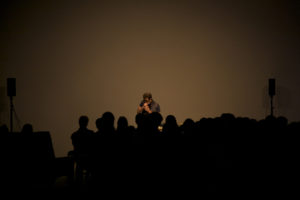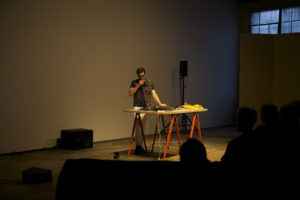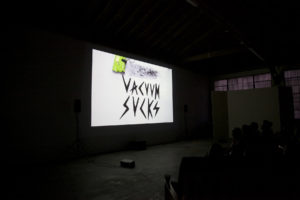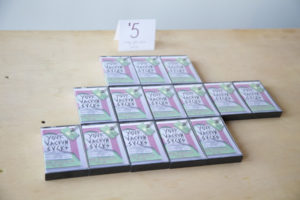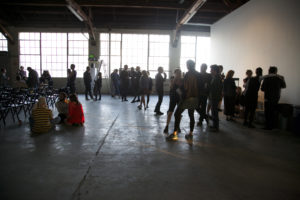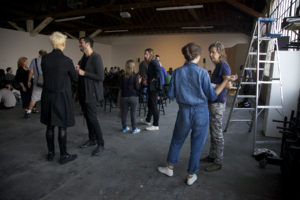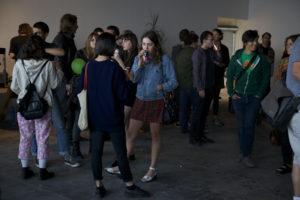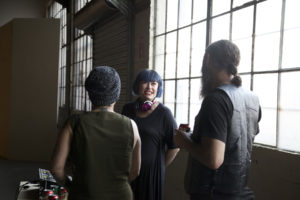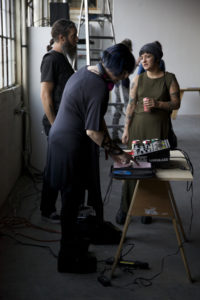Your Vacuum Sucks screening + performance
- Pieter Schoolwerth interviewed by Ethan Swan
Your Vacuum Sucks (2015, 38 min) is a film by Pieter Schoolwerth and Alexandra Lerman. The film will screen at 356 S. Mission Road on Saturday, June 13 at 7 PM, with a performance by Nate Young (Wolf Eyes, Regression).
Ethan Swan: Most people know you as a painter, have you made videos before Your Vacuum Sucks? Do you feel like this video has a connection to your paintings, or is there some kind of break or change at work here?
Pieter Schoolwerth: I’ve long been interested in how the ever-changing forces of abstraction in the world effect the task of representing the human body. This ongoing investigation has caused me to think about how one forms an idea of another’s bodily presence, and how to represent the compression of space and time that is such a part of communicating today. My work of the 1990’s used installation, video and drawing, and later in the 2000’s figurative painting became the medium that seemed the best suited to this task. Over the past few years though I’ve had the opportunity to return to video, thanks largely to meeting Alexandra Lerman with whom I collaborated to make Your Vacuum Sucks, and without whose technical wizardry it would not have been possible, as well as Masha Beliaeva who helped us to create the special effect that turned this whole world on and made it truly “suck” with pleasure. For the moment I’ve come to feel that presenting a dialectic of still and moving images together can do something different than painting can do by itself. Dialogue, body language, and humor on a screen can effect how one experiences related paintings nearby in the gallery space.

Your Vacuum Sucks is a film in which the lead character has been digitally erased from the image. Appearing as a hole, a shadow, or a mirror reflection of his properly embodied friends and coworkers he pays a friendly visit to in each of the seven scenes, he engages in a series of rebus-like exchanges, whereby he is present to others through his visual absence. The moving image on screen is composed of two disparate moments in time compressed, and running along side each other in parallel as separate filmic layers. Everywhere the lead figure’s body appears in the top layer it is ‘sucked-out’ to create a hole, and the empty space of his silhouette filled in with a different take of the same shot showing through the bottom layer, depicting a moment just before, or is it one soon to follow?
The result of this superimposition (which occurs in my both recent paintings and the video) is an image of both spatial and temporal compression – two discrete moments in space and time are represented with a single image of a body. So in a way the figures the lead character is interacting with are feeding back their own images on themselves. This idea has a sort of inverse relationship to that of cubist space: the cubists depicted one body from multiple points of view, I am depicting multiple bodies from one point of view – which is so often the case today when one’s body is firmly planted in front of a screen opened up onto multiple space-less vistas. Maybe you’re simultaneously talking to your Mom about your confusing childhood, your coworker next to you about how the coffee sucks, and a future employer about hopefully getting a better job – and your “body” is flowing through and floating around somewhere in between all of these windows on the world.
ES: Your Vacuum Sucks definitely made me think a lot about space. One of the unexpected things I really liked about the video is how familiar all the locations felt to me. The bedrooms decorated with band posters and dirty laundry, or the garages full of anonymous junk. This kind of mirrors the inspiration for the film, right? You’ve said it started from a very quotidian, domestic moment?
PS: The inspiration for the evolving Your Vacuum Sucks project arose from a rather uncanny experience I had while cleaning my house with a shitty old green vacuum cleaner. I noticed the vacuum wasn’t picking anything up, and out of banal frustration I instinctively blurted out “this vacuum sucks!” I then stopped for a moment to reconsider this curious statement: if it didn’t suck it wouldn’t be a vacuum. In other words, if it works – it sucks, and if it doesn’t work – it sucks. There is (apparently) only one way that the vacuum can work, and be experienced. And the fact that this word can be used both to designate a banal everyday appliance, as well as a larger model for the abstraction of social space (as in “I feel like I’m living in a vacuum”) made this linguistic conundrum all the more intriguing.
I began to see the sentence “if it didn’t suck it wouldn’t be a vacuum” as a sort of feedback loop, which – like the closed circuit of noise triggered by a microphone held up to an speaker – caused me to begin generating a visual scenario that grew more complex the more I thought about it. It felt as though a crack created by language had opened up a new visual ‘vacuum space’ which I wanted to go inside of and create an artwork. I decided to make a video and a related series of paintings generated by a narrative in which a figure whose physical body has been abstracted enters a series of his friends’ and coworkers’ personal vacuums per se, perhaps in an attempt to find a way in which the daily experience of their social space could ‘not suck’, both literally and figuratively.
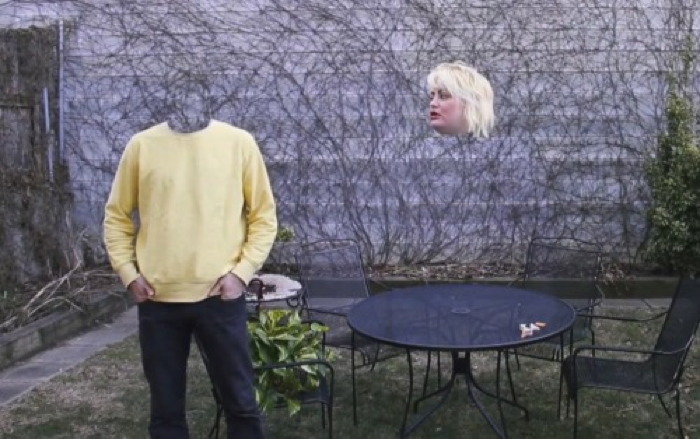
I was determined to escape this feedback loop for the third iteration of the show in NY recently which was entitled Your Vacuum Blows, which Sucks. I’d been stockpiling a pretty abject arsenal of outmoded appliances in my studio that I was using to warp and liquefy images of into the contours of shadows cast by bodies’ and objects’ in my paintings, and I realized that beginning in the early 2000s so many shop vacs began to come equipped with an “airflow reversal switch”, which allows the identity of the object to change from a vacuum to a blower. So for a moment I thought I was finally free – and the vacuum could no longer ‘suck’, because now IT blows. This made sense as (duh) of course my vacuum sucks – there’s no way to breathe without space. I figured if I could finally ‘exhale’ after sucking air in, breathing could finally becomes possible (and the feedback loop would be broken at last).
My joy was short-lived, however, as ‘Blows’ is simultaneously the same and the opposite of ‘sucks’. So If the blower works – it blows; if it doesn’t work – it blows. So now I realized my vacuum blows, which sucks…FTW.
ES: So there’s something radical about the vacuum’s position in a way? This is kind of a leap, but I feel like there’s a connection to extreme art or music here. Like how a power electronics band kind of always wins – either you stay for the set and enjoy it, or you can’t deal with the onslaught and you walk out. Because the stance is an aggressive one, there’s a victory in chasing people out, maybe equal to the one of having fans. Do you have thoughts about this kind of position?
PS: That makes sense, though maybe the more obvious reason people walk out on on power electronics nowadays is watching a lone bro turning on another predictable vacuum of consumer electronics while self-righteously checking his gmail on stage in a hot and steamy fan-less room isn’t terribly exciting. Mark Solotroff and I who have who I’ve long played together in BLOODYMINDED have contrarily spent quite a few years ripping each other apart on stage in an effort to put the physical body back into the vacuum and bring the sweaty heat-seeking fleshly encasement that once housed rock ‘n roll back into noise. Who knows if IT’s worked, but god knows we’ve certainly shared many lovely nights of triumphantly awkward public intimacy together I’ve eminently enjoyed!
But extreme email-encrusted stage presences aside, a vacuum in a way presents an image of space without space. And the manner in which a vacuum sucks material detritus out of the world – by removing it into a chamber that is still ‘in this world’, a space inside the appliance, yet no longer clearly visible as ‘on the ground’ – seems a timely model for the way in which one experience the abstraction of space and the body today. Video imagery operates in a similar ‘nowhere space’, depicting images of things ‘of this world’ once removed as sucked-into a plastic box to glow as pixels of light on a screen.
After my beloved green vac died, I found a very cool faux wood grain model made by a company called Rainbow in the early 70’s that I liked – I figured all the earthy, organic motifs in place might make it slightly less inclined to suck, but unfortunately I still needed to clean the house. This model was also interesting because once sucked inside the detritus was contained within a transparent plastic chamber underneath the body of the machine and readily visible from the outside, as once removed, not unlike a little screen on which to watch the visual trash of the world swirl round on smart devices. This chamber also seemed an intriguing metaphor for the human body’s self-awareness after ingesting food, ideas, and sensations. A few weeks after acquiring my new vacuum I found myself at a New Years Eve party in a certain infamous Michigan basement encased by wood paneled walls and a swirl of reveling partiers, and it struck me: the faux wood vacuum was the basement around me – and I was inside of it, and maybe IT was also inside of me, this was a very rare moment indeed.
ES: If people aren’t familiar with your paintings, they might instead be familiar with the Wierd party/label you did from 2003-2013. I feel like there are a lot of shared themes between Wierd and Your Vacuum Sucks – a preoccupation with social space; an anxiety about absent bodies or dematerialization; word play; even the extreme art/music mentioned above. I know you’ve kept that activity at a distance from your visual art, but is there a way that Wierd informs Vacuum?
PS: Well you’ve certainly written more erudite words than I could eVR scribe here on the topic of Wierd’s ethos on the trials and tribulations of the human body’s drama in social space over the past decade. Suffice it to say, the early 2000’s were a very interesting time to watch how people negotiated their physicality as their lives slowly migrated onto the internet. The party began just before social networks took hold of people’s attention, as the likes of Itunes and torrents began wiping out the music industry and changing how music circulated and what is was used for. So to make a long story short I began to see an an analogy between analogue synthesis and the position of the body in digital space at the time, and getting people out of their cubicles to come together and trying to build a new spirited social body in the night felt very meaningful.
For the 10 years I ran the party I communicated with a list of subscribers through a weekly email I sent every Wednesday afternoon – I would sit down and force myself to cough up a stream of consciousness text in an hour or so, usually connecting thoughts on the abstraction of daily life to the performance that was scheduled to take place in the club that evening. I gradually developed a materialist style of writing (using words more for their word-play and punning value as flexible shapes and sounds), which I hoped would connect to the délire of nightlife, in hopes of evoking a libidinal mental space to inspire people to come out and visit me in the smoke and mirrors of our basement on the LES. I’ve also come to believe the pun may have some connection to a body’s double – a flip side to a word’s meaning always existing in the shadows that can open up visual space.
When I brought the party to an end in February of 2013, I thought I’d miss all the blissed out familiar faces and frozen sounds that grounded that world for so long, but I realized the activity I missed the most was accessing the unmediated freedom valve that came with writing the Weird email text each week. So instead of producing a coffee table book or a documentary film on the party and label, I decided what I really wanted to do was write a script in the spirit of the weekly email. For years I’d kept my music and painting energies very separate, largely in order to keep the subcultural world free of the usurping forces of commerce, and running the label, mail order and booking a hundred or so shows a year took a most of my time. But since taking a break from club culture I’ve come to bring all my focus and time back to making art, and this moment has allowed me to almost start over in a way.
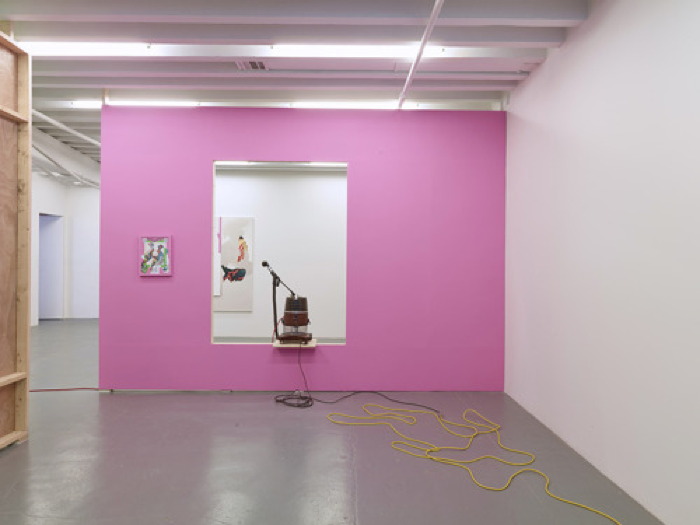
ES: The evolving project of Your Vacuum Sucks began at What Pipeline in Detroit last September, then travelled to Gallery SKE in New Delhi, India in October, and was most recently plugged back in at Miguel Abreu Gallery in April. Can you talk about how the works in this most recent installation related to the film?
PS: For each iteration of the three part project taking place in Detroit, Delhi, and New York I built different arrangements of one-sided walls painted to correspond to the scenes of the video, designated by color bars before each scene. I see the walls as connoting a fantasy space similar to that created by a television set. Many of the walls contain rectangular holes corresponding to displaced paintings that have been ‘sucked out’ of the walls (and displaced to a different part of the room) in a similar way to how the bodies are abstracted and fed back in the video. The painting process begins by taking photographs of the figures and objects depicted in the video, as well as the shadows cast from projecting a light on each in front of a wall. I then start composing on the computer and stretch the images of the figures and objects into their accordant warped shadows, and combine them together into pixelated human-object hybrids, which I print out on canvas. I apply a final layer of painterly intrusions on top of each of these compressed and destabilized bodily images born in the shadowy vacuum, plugging in and thereby turning on the rectangular objects by literally reiterating the previously vacuous, pixilated material surface…in hopes, perhaps, that it does something other than suck.
- Nate Young performance
In conjunction with the screening of Your Vacuum Sucks at 356 Mission on June 13, 2015. Nate did the soundtrack for Your Vacuum Sucks and is one of the stars of the film. A thing that's not visible on the video but was an excellent gag live was the transition from the film to the live set. Nate is in the final scene of the film, and walks offscreen to the right of the frame. Immediately following the film, Nate walked out from behind a fake wall as if he walked off the screen and into the room.
-
Screening + Performance at 356 S. Mission Road:
Your Vacuum Sucks (2015, 38 min)
a film by Pieter Schoolwerth & Alexandra Lermanand
a live performance by Nate Young
Saturday, June 13 at 7 PM
356 S. Mission Road
Los Angeles CA
Tags: Alexandra Lerman, Nate Young, Pieter Schoolwerth


